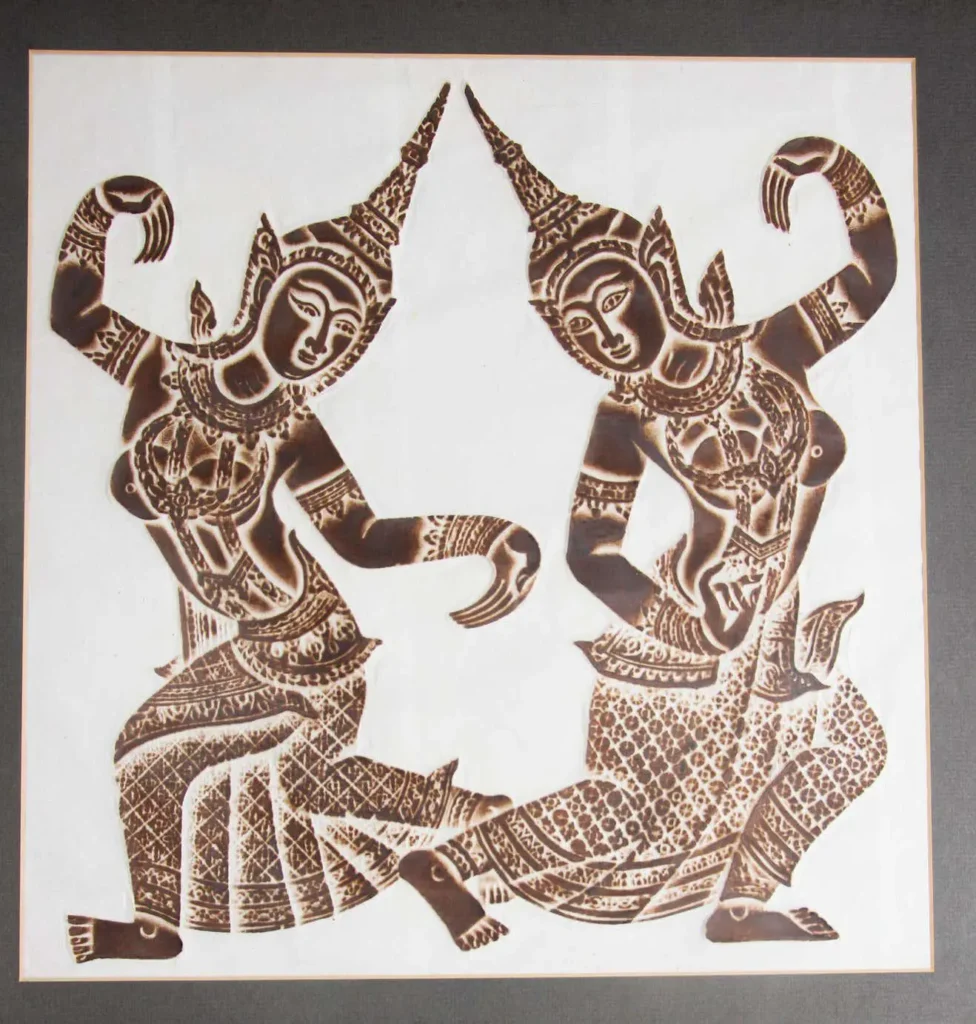
Definition of a Temple Rubbing
Temple rubbing is a unique form of art that originated in East Asia, where impressions of stone inscriptions, sculptures, or carvings from temple walls are transferred onto paper. The process involves placing a sheet of paper on the stone relief and then rubbing it with a special wax or charcoal stick until the image appears clearly on the paper. This method beautifully captures the intricacies of temple artworks, preserving historical and cultural details in tangible form.
Importance & Relevance of Temple Rubbing
Temple rubbing, an age-old practice with historical and cultural significance, bridges the gap between spirituality and artistry. It primarily involves making imprints or rubbings of engravings and textures on temple walls.
Not only does this practice serve as a form of prayer, expressing reverence to deities, but it also enables the preservation and documentation of intricate designs and religious stories etched into these sacred walls. This technique holds paramount significance, especially in Asian cultures, resonating as a medium for cultural retention and spiritual exploration.
History of Temple Rubbing
Origin & Development in Ancient Civilizations
Temple rubbing, an art form and practice with roots in ancient civilizations, primarily emerged in Asia. Traditionally, it was a means to preserve the intricate details of stone-carved reliefs found abundantly across temples. Asian scholars and priests initially used rice paper or silk and rubbed it with charcoal or graphite to capture the inscriptions, embellishments, scripts, or figures.
This practice gained popularity among western travelers, historians, and archaeologists in the 19th century as a quick and easy, yet highly accurate, representation of historical records. Over the centuries, it evolved as a distinctive art form and holds much cultural and educational significance today.
Temple Rubbing in Asian Countries
Temple rubbing, a centuries-old art form, has particularly significant roots in Asian countries. Notably, in regions like Cambodia, Thailand, and China, it served not only as a means for pilgrims to capture spiritual memories but also as an instrument for scholars to study ancient inscriptions.
For instance, China’s complex stone inscriptions dating back to the Tang Dynasty were often studied via rubbings. Similarly, in Cambodia, temple rubbings were instrumental in understanding the architectural marvel that is Angkor Wat. Thus, the tradition of temple rubbing in these countries provides a unique peek into their rich historical and cultural tapestry.
Evolution of Temple Rubbing over the Centuries
Throughout the centuries, the practice of temple rubbing has continuously evolved. Originally a form of veneration and record-keeping in ancient Asia, rubbings were used to capture the complex details of temple stonework and inscriptions.
This art form gradually spread to Europe during the Middle Ages and was used for duplicating holy texts and relics. In the modern era, temple rubbing has been adopted by tourists as a unique souvenir and artistic hobby, notably in places like Cambodia’s Angkor Wat. Despite its transformation, the essence of temple rubbing as a means of preserving cultural heritage remains the same.
Related: The Fascinating Story Of The ‘Si-Te-Cah’ And The Lovelock Cave
Materials and Tools Used
Types of Paper Used
In the creation of temple rubbings, the choice of paper is crucial, as this greatly affects the outcome. Artisanal or handmade paper, preferably rice paper, is often chosen for its flexibility and strength, which allow it to capture intricate designs from the relief surface without tearing.
Tracing paper is another popular option. Its translucent quality permits you to see the surface underneath, ensuring accurate translation of the images onto the paper. Charcoal papers are also used, recognized for their rough texture that can hold charcoal or other mediums efficiently. The selected paper type is dependent on personal preference and the medium being used.
Variety of Rubbing Mediums
A myriad of mediums can be employed in creating temple rubbings, each lending its own unique characteristics to the final artwork. The most traditional medium being used throughout centuries is a specific type of wax crayon, known for its durability and vibrant output. Soft-lead pencils and chalks are preferred by some due to their ease of use and lightweight nature.
Alternatively, others opt for charcoal for its sharp contrasts and unique texture. Recently, artists are also experimenting with fabric paint and oil pastels to achieve diverse effects. Hence, your choice of rubbing medium should depend on the desired texture, intensity, and final look of the art.
Brush and Other Tools for Temple Rubbing
When engaging in temple rubbing, various tools are utilized to execute the task meticulously. The fundamental and indispensable tool is a brush, typically a soft-bristle variant. This type of brush enables the user to gently rub without damaging the delicate surface underneath.
Other tools that significantly supplement the process include a special type of paper that is ideally suited for capturing the impression and a specific type of rubbing wax or crayon that is carefully used over the paper against the textures and features of the temple surface. It’s paramount to use these tools correctly to yield a perfect temple rubbing without causing any harm.
Procedure for Temple Rubbing
Preparation Process
Before you begin temple rubbing, it’s crucial to have the proper materials and an appropriate disposition. You’ll need lightweight, translucent paper and blunt crayons or chalk. Once you’re on-site, ask for permission if it’s needed. Approach the activity with respect, as these structures are often sacred sites. Next, secure your paper onto the surface, making sure it doesn’t shift.
Consider using masking tape, but be sure it won’t damage the surface. Gently rub your crayon over the paper, capturing the intricate details beneath. It’s important to work slowly so as not to tear the paper or miss any delicate features. Enjoy the process as a meditative activity.
Actual Rubbing Technique
In executing the temple rubbing technique, light, moderate, or firm pressure is applied, depending on personal comfort. Start by placing your index and middle fingers on your temples. Glide your fingers in small, circular movements, slowly expanding the circles as needed. This technique is often performed for 5–10 minutes but can be continued for longer if desired.
A rhythmic pace is recommended, matching your breathing for enhanced relaxation. Adding essential oils like lavender can heighten the experience, encouraging further relaxation. Do remember, though, to always clean the area first to avoid skin irritation when oils are used.
Steps to Preserve and Protect Temple Rubbings
To conserve and shield your temple rubbings, begin by gently placing them on a flat surface. Handle it with clean hands to prevent oil and dirt from causing damage. To preserve the texture, avoid direct contact and use acid-free tissue paper when moving it.
Safeguard from extreme temperatures, humidity, or sunlight, which can cause fading. To prevent discoloration, it’s advisable to frame the rubbing using UV-protective glass. Keeping it in acid-free folders or boxes can also effectively safeguard against dust and damage. Regularly inspect the rubbing for mold or insects and take timely action. Remember, proper care can significantly extend the life of your temple rubbing.
Significance and Interpretation of Temple Rubbing Art
Spiritual Significance
The spiritual value of temple rubbings extends beyond mere decoration. For believers, it serves as a gateway to connecting with the divine. This method of art is often interpreted as a tangible imprint of faith and devotion, capturing centuries-old traditions and spiritual narratives on paper, thereby providing a tactile spiritual meditation that nurtures connection with higher powers.
Temple Rubbings as Historical Records
Temple rubbings serve as critical historical records, providing a gateway to the past. They capture the intricate details of stone carvings and inscriptions and shed light on the artistic, religious, and cultural elements of different time periods, particularly from the East Asian regions.
The intricate traces bring forgotten narratives to life, enabling historians and researchers to interpret and understand past civilizations more profoundly. As a form of preservation, these rubbings document the rich tapestry bookmarking our existence, helping to bolster our understanding of human history. Hence, each rubbing is not just an artwork but a piece of historical evidence filled with stories waiting to be unraveled.
Interpreting Temple Rubbing Art
Interpreting temple rubbing art is similar to solving an ancient puzzle. Each piece, created through the delicate process of rubbing, reveals unique insights about the historical and cultural context of the temple. Without any words, these intricate artworks narrate tales of past societies, religious beliefs, and architectural prowess.
Notably, symbols, patterns, and images in the rubbing can provide spiritual or philosophical teachings specific to the temple’s traditions. Moreover, the quality of the rubbings, such as detail clarity and line consistency, can indicate the artist’s skills and techniques. Therefore, appreciating these artworks requires both cultural understanding and aesthetic judgement.
The current status of temple rubbing and the ethical aspects
Modern-day Practice and Respect for Cultural Heritage
In today’s era, temple rubbing is a delicate balance between cultural appreciation and preservation. Although it is occasionally practiced as a means to capture intricate details and the historical relevance of a temple’s artwork, there are concerns about potential damage to these ancient structures.
Many locations restrict this activity to safeguard their historic relics. In this context, practitioners need to respect local customs and regulations. It’s crucial to value these sites as precious vestiges of cultural heritage and not just artistic resources. Sustainable and respectful practices should be promoted to preserve the integrity of these monuments for future generations.
Legal and Ethical Considerations for Temple Rubbing
Temple rubbing, once a popular activity, is now viewed through the lens of preservation and respect for cultural heritage. Many countries, particularly those in Southeast Asia, have laws in place prohibiting the practice to protect the integrity of these ancient edifices.
The ethical considerations are rooted in cultural respect and the understanding that these structures necessitate careful handling to conserve them for future generations. Acts like these can potentially cause irreversible damage, thereby diminishing their historical and cultural value. As such, it’s imperative for tourists to respect these protective measures and understand the importance of heritage conservation.
Conclusion and Future Perspectives
Current Trends and Future Perspectives on Temple Rubbing
In the realm of artistic and cultural exploration, temple rubbing has gained popularity as a strong connector of the past with the present. Today, people are using advanced materials like graphite and archival papers to preserve their heritage.
Even digitally enhanced reproductions are gaining momentum, ensuring this intricate craft thrives in the digital age. It is expected that in the future, with the support of virtual reality (VR) and augmented reality (AR) technologies, enthusiasts will be able to experience temple rubbing in more immersive ways. As technology continues to evolve, the possibilities are limitless for the endurance of this age-old tradition.



